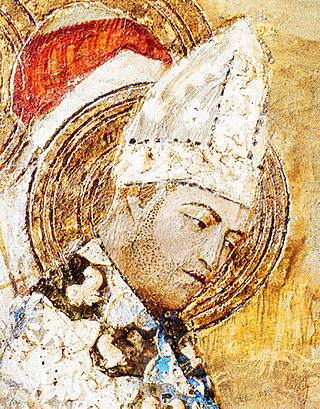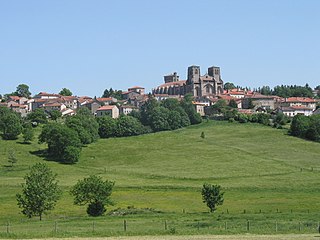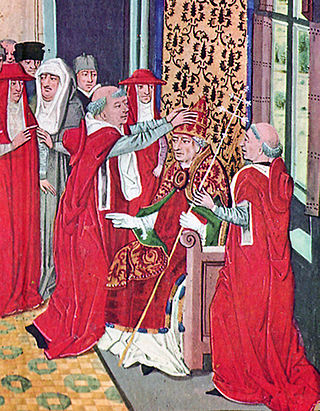
Pope Clement VI, born Pierre Roger, was head of the Catholic Church from 7 May 1342 to his death, in December 1352. He was the fourth Avignon pope. Clement reigned during the first visitation of the Black Death (1348–1350), during which he granted remission of sins to all who died of the plague.

La Chaise-Dieu is a commune in the Haute-Loire department in south-central France. Its inhabitants are called Casadéens, from the Latin name of the city.

Adelelmus was a French-born Benedictine monk venerated as a saint in the Roman Catholic Church.

The Diocese of Le Puy-en-Velay is a Latin diocese of the Catholic Church in France. The diocese comprises the whole Department of Haute-Loire, in the Region of Auvergne-Rhône-Alpes.

Mozac Abbey is a former Cluniac monastery in the commune of Mozac near Riom in Auvergne, France.

Maillezais Cathedral is a ruined Roman Catholic church in the commune of Maillezais in the Vendée, France. Formerly the site of the Abbey of Saint-Pierre, the site grew from the 10th century abbey to the cathedral completed in the 15th century, with the many structures at the site abandoned by the end of the 17th century. Today's ruins consist of a cathedral, refectory, dormitory, kitchen, cellars, turrets and ramparts. The cathedral has been declared a heritage monument in reflection of its Romanesque and Gothic architectural form. It was designated a monument historique on 30 January 1924. The cathedral belonged to the Diocese of Luçon, with Roman Rites, and with St. Peter as the patron saint.

The Archdiocese of Clermont is a Latin archdiocese of the Roman Catholic Church in France. The diocese comprises the department of Puy-de-Dôme, in the Region of Auvergne. The Archbishop's seat is Clermont-Ferrand Cathedral. Throughout its history Clermont was the senior suffragan of the Archdiocese of Bourges. It became a metropolitan see itself, however, in 2002. The current archbishop is François Kalist.

Lavaudieu is a commune in the Haute-Loire department in south-central France. It is a member of Les Plus Beaux Villages de France Association.

Guy of Boulogne was a statesman and cardinal who served the Avignon Papacy for 33 years. He participated in the papal conclaves of 1352, 1362 and 1370, and was the Subdean of the Sacred College of Cardinals. His diplomatic postings were extensive, including Hungary, Italy, and Spain. He headed an effort to end the Hundred Years' War. The historian Kenneth Setton called him "one of the commanding figures of his day, and the letters of Petrarch abound with references to him".

Psalmody Abbey, also Psalmodie Abbey or Psalmodi Abbey, was a Benedictine abbey located near Saint-Laurent-d'Aigouze in the Camargue, in the department of Gard and the region of Languedoc-Roussillon in the south of France. It was destroyed in 1703.

Nicolas de Besse was born in the diocese of Limoges, in 1322. He was a French bishop and Cardinal. He was the son of Jacques de Besse, Seigneur de Bellefaye and Almodie (Delphine) Roger, sister of Pope Clement VI. He had a brother Pierre de Besse, who became Seigneur de Bellefaye and who married Margueritte de Thiers. Nicolas de Besse died in Rome on 5 November 1369.

Robert de Turlande was a French Roman Catholic priest and professed member of the Order of Saint Benedict. He was of noble stock and was also related to Saint Gerald of Aurillac. He is best known for the establishment of the Benedictine convent of La Chaise-Dieu and for his total commitment to the poor.

Romanesque architecture appeared in France at the end of the 10th century, with the development of feudal society and the rise and spread of monastic orders, particularly the Benedictines, which built many important abbeys and monasteries in the style. It continued to dominate religious architecture until the appearance of French Gothic architecture in the Île-de-France between about 1140 and 1150.

Église Saint-Pierre-et-Saint-Paul is the Catholic parish church of the village of Neuwiller-lès-Saverne, in the Bas-Rhin department of France.
Preuilly Abbey was a Benedictine monastery in Preuilly-sur-Claise, Indre-et-Loire, France. The surviving abbey church retains many Romanesque features, notably the intricately carved capitals.

Saint-Maur Abbey, originally called the Abbaye des Fossés, is a former abbey now subsumed in the Saint-Maur-des-Fossés suburb of Paris, France. The remains and the domain of the abbey have been transformed into a pleasure park named Parc de l'abbaye. The former abbey building has been replaced by a square at the corner of Avenue de Condé and Rue de l'Abbaye. Some ruins remain, such as the Rabelais tower, the 19th century Bourières villa and the old fortifications. The remains of the abbey have been classified as historical monuments since 13 June 1988.

Solignac Abbey, or the Abbey of Saint-Peter and Saint Paul of Solignac, is an abbey in Solignac, near Limoges, in Haute-Vienne. It was founded around 631 AD by Saint Eligius (Éloi). The present buildings date to the 12th century, but have been modified many times since then. The abbey was dissolved during the French Revolution and the buildings were put to new uses, including a prison, boarding school, porcelain factory and seminary. As of 2021 there were plans to restore it back to its original function as a monastery.

The Abbey of Saint-Antoine was the mother abbey of the Hospital Brothers of Saint Anthony. It is located in Saint-Antoine-l'Abbaye, in the department of Isère, in France. It includes an abbey church and premises that once housed the monks' homes.

Aurillac Abbey, otherwise the Abbey of Saint Gerald, Aurillac, founded around 895 in Auvergne by Count Gerald of Aurillac, destroyed during the French Wars of Religion and suppressed with the Revolution, was one of the oldest Benedictine abbeys, and probably influenced, in its arrangements and organization, the foundation of Cluny itself.





















